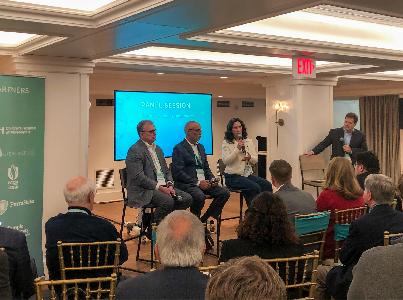The economic case for getting computer science education built into public school curriculum is a glaring one: There are a half-million tech jobs currently unfilled around the country, largely due to a technical skills gap.
But given the tech industry’s diversity problem, equity and inclusion must be key components of the conversation around those high-paying jobs, and who will have access to the benefits they represent.
Cameron Wilson, the COO for coding education access portal Code.org, laid out a a three-part plan for increasing access to computer science education in the country, and for doing to in an equitable way. Wilson was the keynote speaker at a diversity-focused event held on Wednesday by the Philadelphia Alliance for Capital and Technologies (PACT). The event also featured presentations from two local nonprofits working to diversify the local tech ecosystem: Coded by Kids and ChickTech Philly.
Here’s the roadmap Wilson laid out:
1. Break through the stereotypes in computer science.
The theme around representation is one we’ve heard a bunch. You’ll be unsurprised to find that, in the organization’s experience, representation is especially powerful at the K-12 stage.
“We need to make sure that students have role models from underrepresented groups,” Wilson said.
In addition, the organization says it’s imperative to bust through the perception of computer science’s as some sort of inaccessible black box, and increase exposure to tech among youth.
The Hour of Code campaign, which organized over 220,000 coding education events last year alone, is one way to demystify computer science. But about more than code itself.
“The goal isn’t to tech them computer science but to get them excited about it and show teachers that there is interest in this,” said Wilson.
2. Change policies at the state district and federal levels.
Requiring that schools offer computer science education, as an elective course at first, can be a powerful tool to open the door.
“At least one course so that if a student is interested in CS, they have the opportunity to take it,” Wilson said.
Two more key steps: funding professional development for in-service teachers to learn how to code and establishing K-12 computer science education standards — the guidelines that tells school what CS education is and what high quality looks like.
Wilson says this can help give students access to actual computer science, and learn how to create with technology, as opposed to more generic technology or digital literacy classes. Currently, 48 states have some form of policies to expand computer science education.
“This is the level of momentum and excitement we’re seeing around computer education,” Wilson said.
(Locally, the #CS4Philly coalition is working to shape what computer science could look like in Philly’s public schools.)
3. Prepare teachers with no CS background.
It may seem counterintuitive, Wilson admits, but giving coding training to non-technologist teachers has helped spur excitement on the subject. It has carried over to students, too, Wilson says.
Join the conversation!
Find news, events, jobs and people who share your interests on Technical.ly's open community Slack

Philly daily roundup: Women's health startup wins pitch; $204M for internet access; 'GamingWalls' for sports venues

Philly daily roundup: East Market coworking; Temple's $2.5M engineering donation; WITS spring summit

Philly daily roundup: Jason Bannon leaves Ben Franklin; $26M for narcolepsy treatment; Philly Tech Calendar turns one

